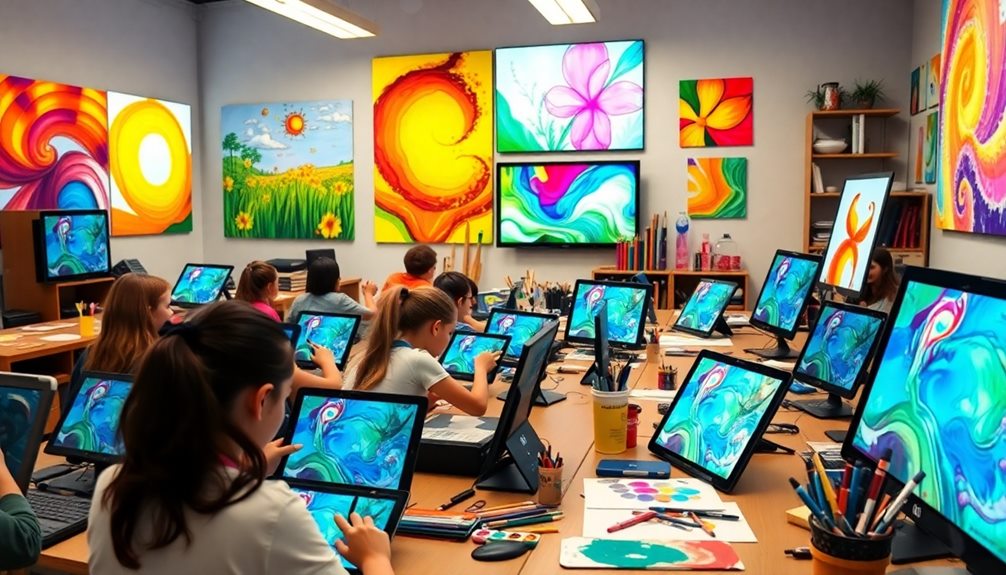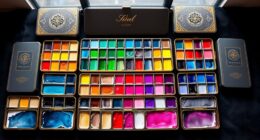Incorporating technology in art education can transform your creative experience. You'll explore diverse digital tools like Adobe Photoshop or Procreate, which make it easy to experiment and revise your artwork. Interactive platforms enhance engagement, while virtual exhibits expand your access to global art. Using digital portfolios helps you track progress and share your work with classmates. Plus, these skills are essential for future careers, as many art jobs require digital proficiency. Embracing these methods can make art more enjoyable and relevant, and you might discover even more innovative approaches as you continue exploring this exciting topic.
Key Takeaways
- Integrate digital tools like Adobe Photoshop and Procreate to enhance creative exploration and skill development in students.
- Utilize interactive whiteboards and collaborative platforms for real-time feedback and engaging learning experiences.
- Offer virtual art exhibitions and online resources to expand access and exposure to diverse artworks.
- Incorporate personalized learning experiences through technology to cater to varied learning styles and increase student motivation.
- Provide ongoing professional development and support for educators to effectively integrate technology into art education.
Importance of Technology in Art Education
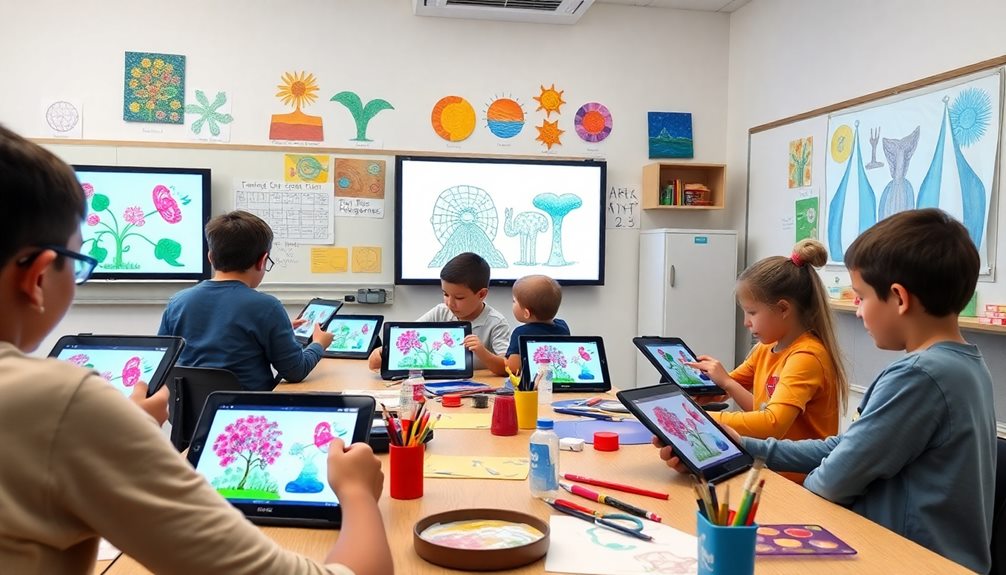
In today's art education landscape, technology's role is essential for enhancing students' creative exploration. The importance of technology in this field can't be overstated; it allows you to experiment with diverse digital tools like Procreate and Adobe Photoshop, encouraging innovative artistic expression.
These digital mediums facilitate easy corrections and revisions, fostering a positive creative process that helps you embrace risk-taking rather than fearing mistakes.
Moreover, technology promotes student engagement through interactive whiteboards and digital portfolios, making learning more dynamic and responsive to your needs.
Virtual exhibitions and online platforms expand your access to a wider array of artworks, enabling collaborative learning with peers from different backgrounds. This connection enriches your artistic perspective and nurtures a sense of community.
As you navigate your art education journey, remember that the integration of technology not only enhances your current experience but also prepares you for future careers.
With over 60% of art-related jobs linked to digital art skills, being proficient in these tools is vital. Embracing technology in art education equips you with the skills necessary to thrive in modern creative industries.
Evolution of Art Education
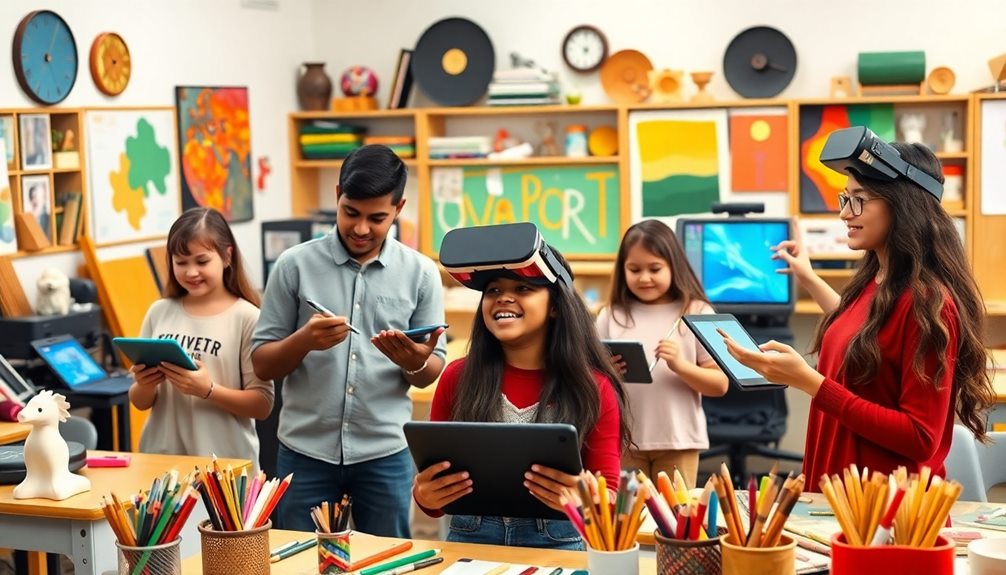
Throughout history, art education has undergone remarkable transformations, reflecting societal changes and evolving perceptions of creativity. In the Middle Ages, it primarily focused on skilled craftsmanship. However, the Renaissance introduced a more formalized curriculum in academies, emphasizing artistic training and theory. By the 20th century, art became integral to general education in public schools, highlighting its role in holistic student development.
The incorporation of hands-on learning experiences, similar to Montessori Toys, has also become a focus, promoting creativity and problem-solving skills among students.
Today, advancements in technology in the art world have considerably broadened access to art education. Digital tools facilitate remote learning and enable students to create and showcase their work in innovative ways. Institutions like Rocky Mountain College of Art + Design exemplify this evolution by blending traditional art techniques with modern digital methods, preparing you for diverse artistic careers.
Integrating technology into arts education has transformed teaching approaches, fostering a more interactive and engaging learning environment. Students from various backgrounds can now explore both modern art and traditional art forms, utilizing multimedia resources to enhance their creative expression.
This evolution not only enriches your educational experience but also equips you with the skills necessary to thrive in today's dynamic artistic landscape.
Essential Digital Tools

When it comes to essential digital tools in art education, digital drawing applications like Adobe Photoshop and Procreate are game changers for your creative process.
If you're interested in 3D modeling, software such as Unreal Engine and Cinema 4D can open up new avenues for your artistic expression.
Embracing these technologies not only enhances your skills but also prepares you for the future job market in the arts.
Digital Drawing Applications
Digital drawing applications have revolutionized the way art is taught and created, providing crucial tools for both students and educators. With programs like Procreate and Adobe Photoshop at your fingertips, you can easily create and edit artwork, making these applications essential for modern art education. These tools encourage a positive creative process, as you can draft and correct your work unlimitedly, fostering experimentation among art students.
Many digital drawing applications come equipped with layers, brushes, and filters, allowing you to explore various artistic styles without the limitations of traditional materials. User-friendly interfaces found in apps like FlipaClip and ArtStudio promote confidence in beginners, making it easier for you to immerse yourself in digital arts.
Here's a quick overview of some key features:
| Application | Key Features | Ideal For |
|---|---|---|
| Procreate | Custom brushes, layers | Advanced art students |
| Adobe Photoshop | Extensive editing tools | Professional artists |
| FlipaClip | Animation tools, easy UI | Beginners |
| ArtStudio | Variety of brushes, layers | Intermediate users |
Integrating these applications into your curriculum not only enhances your creative use of technology but also prepares you for future careers requiring 21st-century learning skills.
3D Modeling Software
Harnessing the power of 3D modeling software can transform your approach to art education, especially if you're interested in character design or video game development. Tools like Unreal Engine and Cinema 4D are vital for creating realistic and complex digital environments, pushing the boundaries of your creativity.
By incorporating these programs into your curriculum, you can foster an environment where students experiment with spatial design and visualization techniques, which are foundational skills in various artistic and technical fields. Additionally, the exploration of how materials influence artistic expression can be integrated into 3D projects, allowing students to reflect on the cultural significance of their designs.
As technology continues to shape the job market, art education programs increasingly emphasize digital art skills, integrating 3D modeling into their training. This integration not only enhances artistic expression but also prepares students for future careers in animation, architecture, and product design.
Moreover, access to 3D modeling software enables students to collaborate on projects virtually, simulating real-world professional environments where teamwork and digital skills are essential.
Embracing these vital digital tools in your art education journey will empower students to express their ideas more vividly and effectively, bridging the gap between traditional artistic practices and modern technology.
Techniques for Integration
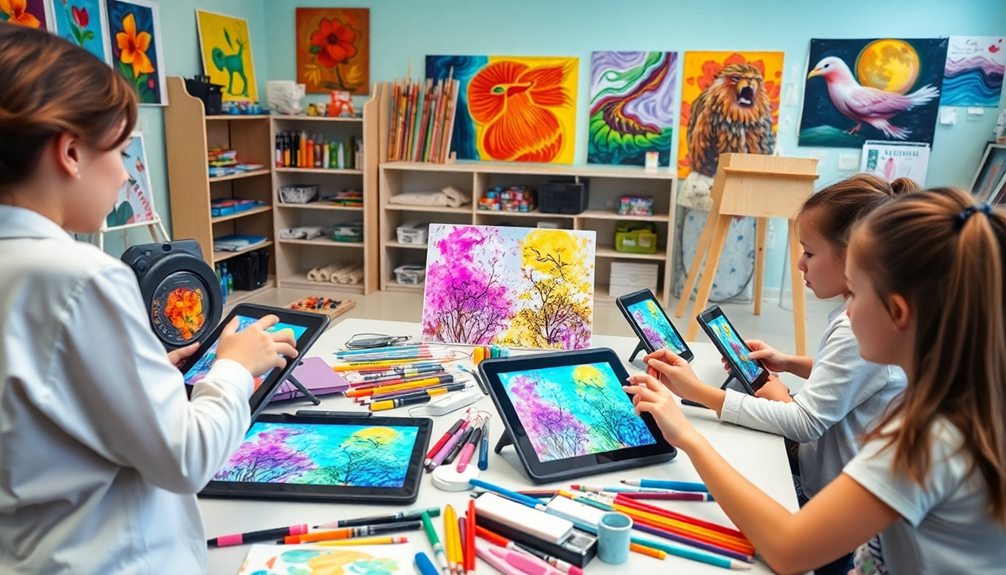
Integrating technology into art education opens up a world of creative possibilities for students. By utilizing digital tools like Adobe Photoshop and Procreate, you allow students to create diverse art projects that blend traditional techniques with innovative methods. Introducing 3D modeling software such as Unreal Engine and Cinema 4D can further engage students in character design and video game development, bridging art and technology.
Interactive whiteboards in your classroom encourage collaborative learning, enabling students to share their ideas and artworks in real time. This fosters a vibrant community of creativity, where critical thinking thrives. Additionally, apps like SeeSaw and Artsonia help organize student work through digital portfolios, making it easier to track progress and provide feedback.
To illustrate these techniques for integration, consider the following table:
| Technique | Benefits | Tools/Resources |
|---|---|---|
| Digital Drawing Tools | Diverse mediums for art-making | Adobe Photoshop, Procreate |
| 3D Modeling Software | Engages in character design | Unreal Engine, Cinema 4D |
| Interactive Whiteboards | Encourages collaborative learning | Smartboards |
| Virtual Tours | Access to global art resources | Online museum platforms |
Challenges of Technology Use
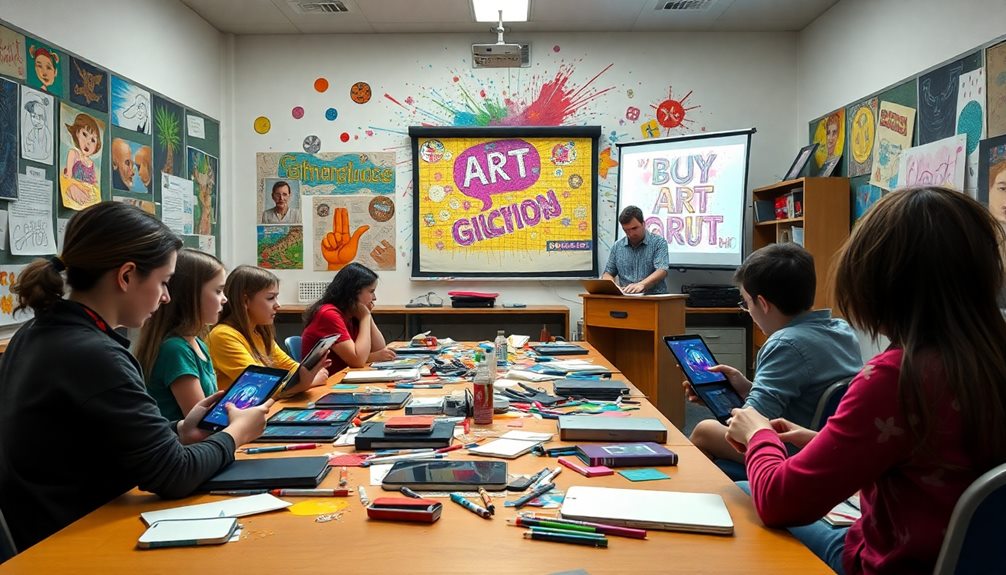
You'll quickly notice that technology use in art education isn't without its challenges.
Not everyone has equal access to devices or reliable internet, making it tough for some students to engage fully.
Plus, the varying learning curves and the need for ongoing support can put pressure on both you and your fellow educators.
Accessibility Issues in Education
When it comes to incorporating technology in art education, accessibility issues can really hold back students from fully engaging with digital tools. Not every student has reliable access to technology or the internet, which can hinder their ability to utilize art education technology effectively. Approximately 20% of K-12 students face barriers to technology access, making it essential to implement equitable solutions.
To address these diverse needs, inclusion strategies must be prioritized. Here's a quick overview of some key considerations:
| Accessibility Issue | Impact on Students | Possible Solutions |
|---|---|---|
| Limited Internet Access | Hinders participation | Provide hotspots or devices |
| Insufficient Training | Affects tech confidence | Offer workshops for skills |
| Diverse Learning Styles | Creates engagement gaps | Use varied teaching methods |
| Resource Scarcity | Limits creative opportunities | Secure funding or grants |
| Lack of Ongoing Support | Causes frustration | Establish mentoring programs |
Learning Curve Challenges
How can educators effectively navigate the learning curve challenges that come with incorporating technology in art education? The varying learning curves for new digital tools can greatly impact your students' ability to engage. Without formal instruction, as many as 30% of students might struggle, leading to frustration and disengagement.
To address this, you need to provide adequate support and training to guarantee all students feel comfortable using these tools. Additionally, recognizing patterns of emotional coldness, such as feelings of neglect, can help educators understand the emotional landscape of their students and foster a more supportive environment professional counseling may help couples reconnect.
Accessibility issues, like limited internet access or a lack of devices, can further complicate technology adoption in your classroom. You must recognize these barriers and find ways to mitigate them. Incorporating differentiated instruction and peer mentoring can help create a more equitable learning environment.
By facilitating collaboration between students, you'll enhance their understanding and use of digital tools. Additionally, ongoing support for yourself is vital. Many educators report feeling unprepared to teach digital art techniques due to rapid technological advancements.
Staying informed about new resources and strategies will empower you to guide your students effectively through the learning curve. Embracing these approaches can lead to a more successful integration of technology in art education.
Support for Educators Needed
Maneuvering the complexities of technology integration in art education requires robust support for educators. As a teacher, you're likely steering through a steep learning curve with digital tools, and without adequate resources, this can feel overwhelming.
Here are three significant areas where support is essential:
- Professional Development: Ongoing training is fundamental. You need structured opportunities to learn how to adapt traditional art lessons for online platforms effectively.
- Access to Resources: Not every art classroom has equitable access to technology. Addressing accessibility issues guarantees that all students can benefit from tech integration, regardless of their background.
- Infrastructure Investment: Continuous investment in educational technology is essential. Without updated tools and infrastructure, integrating technology into your curriculum becomes a significant challenge.
Enhancing Student Engagement

In the fast-paced world of art education, incorporating technology can appreciably enhance student engagement. By leveraging digital tools like Plickers, you can promote active participation, transforming passive learning into an interactive experience.
Platforms such as Kahoot and Google Forms provide immediate feedback, creating a fun and motivating environment that excites students about art.
When students use technology, they often report higher levels of motivation, thanks to personalized learning experiences tailored to their unique interests.
Virtual art experiences, like museum tours and online activities, foster immersive learning, allowing students to connect with art in ways that resonate deeply. This depth of engagement encourages them to explore further and think more creatively.
Additionally, utilizing social media to showcase student artwork not only promotes engagement but also cultivates a sense of community and pride in their creative accomplishments.
By integrating these tech resources, you can appreciably enhance your students' engagement in art education, ensuring that they not only learn but also thrive in their creative thinking and expression.
Embracing art and technology together opens new avenues for exploration and connection in your classroom.
Collaborative Learning Opportunities
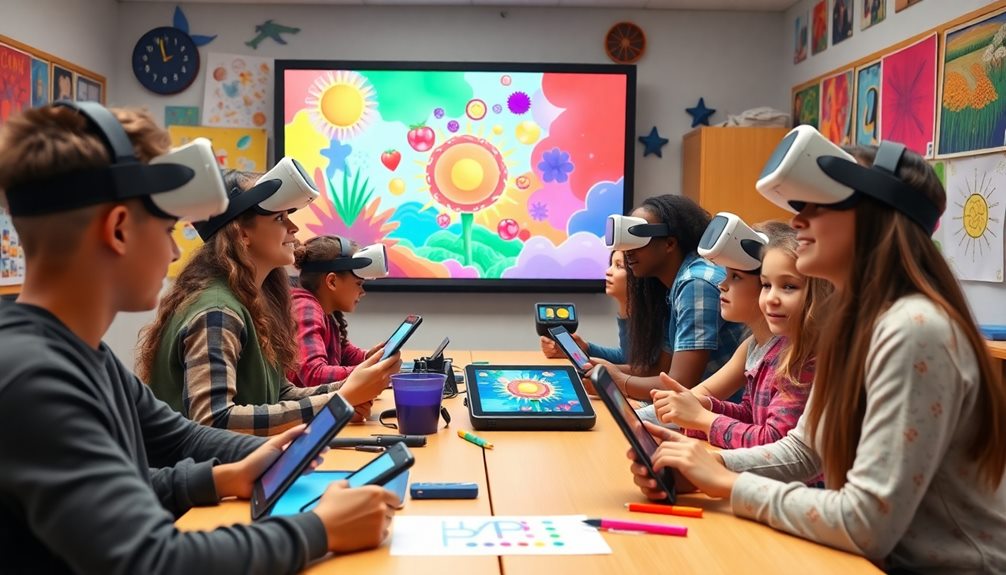
Building on the excitement generated through technology in art education, collaborative learning opportunities can greatly enrich students' creative journeys.
By leveraging digital tools, you can encourage teamwork and foster communication among peers, making art a shared experience. Here are three ways to enhance collaborative learning:
- Virtual Art Exhibits: These platforms allow students from diverse backgrounds to share their work, broadening their artistic perspectives and fostering a sense of community.
- Real-time Feedback: Tools like Google Drive and Padlet enable students to give and receive feedback on each other's projects instantly. This peer learning enhances their skills and confidence.
- Co-creation: Online platforms facilitate co-creation of artworks, enabling you and your classmates to collaborate across different locations. This experience deepens your understanding of various artistic techniques and ideas.
Future Trends in Art Education

As art education evolves, several key trends are shaping the future of how you'll learn and create. One significant trend is the integration of STEAM approaches, emphasizing the importance of interdisciplinary learning. You'll increasingly use digital tools to enhance your skills and creativity, as digital art becomes essential for career readiness in creative industries.
| Trend | Description | Importance |
|---|---|---|
| Technology Integration | Incorporating digital tools in art curricula | Prepares you for future careers |
| Inclusivity | Diverse curriculum design for all students | Fosters creativity and expression |
| Professional Development | Ongoing training for educators | Keeps curricula relevant |
With over 80% of Americans consuming news through digital devices, digital literacy skills are critical. As two-thirds of art-related jobs with salaries over $60,000 are tied to digital art, programs must prioritize these skills. You'll also find that 21st-century learning skills are essential in steering through this tech-rich world. Ultimately, the future of art education focuses on adaptability, ensuring you're well-equipped for success in a rapidly changing landscape.
Frequently Asked Questions
How Does Technology Relate to Art Education?
Technology's revolutionizing art education by providing tools that enhance creativity and accessibility. You can explore digital mediums, collaborate easily, and showcase your work effectively, preparing you for a future where tech skills are essential.
How Can Technology Be Used in Art?
You might not realize it, but technology transforms how you create art. You can explore digital tools, design characters, or curate virtual exhibits, enhancing your skills and broadening your artistic perspective like never before.
How Can Art and Technology Go Together?
Art and technology blend seamlessly when you use digital tools to express creativity. You can explore new mediums, collaborate with peers, and showcase your work online, enhancing your artistic skills and broadening your creative horizons.
What Is the Importance of Technology in Improving Art Skills?
Imagine painting with a digital brush that never runs dry. Technology sharpens your art skills by offering instant feedback, diverse tools for experimentation, and a platform to showcase your growth, making creativity more accessible and engaging.
Conclusion
Incorporating technology in art education transforms how you teach and learn. As the saying goes, "a picture is worth a thousand words," and digital tools help you express ideas more vividly than ever. By embracing these innovations, you not only engage students but also prepare them for a future where creativity and technology go hand in hand. Keep exploring new techniques and methods, and watch your students thrive in this dynamic learning environment.
